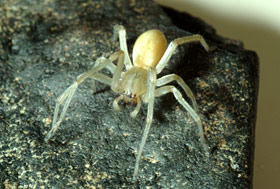Spiders, Arachnida (non-poisonous): Wolf Spiders, Lycosa spp.; Jumping Spider, Phidippus audax; Yellow Sac Spider, Cheiracanthium spp.

Yellow sac spider. Photo by Joseph Berger, Bugwood.org.
IPM Steps to Reduce Spiders
1. Sample for Pest
Confirm the presence of these pests.
Where to find it while inspecting: Spiders are found in areas where a supply of food is near—in this case, insects. Look in areas behind, above, and below traffic areas: small crevices, behind utility boxes, inside light fixtures, etc. Wolf spiders do not create webs, so you are most likely to only find one by chance, or by looking in good hiding places: gaps around doors and windows, under shelving, etc. The yellow sac spider makes small concentrated webs indoors for the winter. Windowsills and inside screens in areas that don’t receive sun are common areas.
Before you act, determine what is crawling around on your floor.
Size and Particulars: Wolf spider: body 1", up to 2" overall with legs; jumping spider: small black spiders, hairy, 1/2" body, short thick legs. Body has small orange to red spots; yellow sac spider is yellow, 1/4–3/4" body—double that with long thin legs, especially the front ones which are the longest.
3. Learn the Pest Biology
Knowing the life cycle and habitat needs helps you fight these pests.
Life Cycle:
Preferred Food Sources: Insects: adults, larvae, and eggs.
Preferred Habitat: Undisturbed areas where there is insect activity such as house flies, moths.
4. Determine Threshold
Spiders are unpopular guests, but what is your threshold for infestation? When should you act?
Threshold: There will always be spiders finding ways into buildings. For the most part, keeping areas clean and “disturbed” will reduce problems. If you find one spider, you may kill it, capture it for a science teacher, or capture and release outside. (Spiders can be considered beneficial invertebrates as they eat insects including pests). Capture them in a clear plastic cup or container pressed against a wall, and slip a piece of stiff paper along the wall to cover the container.
5. Choose Tactics
IPM for indoor pests is always a combination of exclusion and sanitation: Try to keep them out. Don’t provide water, food and shelter if they enter your building.
Best Management Practices: Vacuuming or sweeping in out of the way places behind, above and under tends to deter spiders. Reducing clutter and food sources for other insects reduces insects as food for spiders.
Treatment Methods: For the most part spiders do not cause problems other than the fact people don’t like them. Spiders can bite and will when handled or when they inadvertently end up against your body. In the case of gathering spiders and their hatching eggs, a vacuum cleaner with a bag is the best defense. Vacuum and immediately move vacuum outside, remove bag into a trash bag, close and dispose promptly. Brown Recluse and Black Widow are the spiders of concern.
6. Evaluate
Was the tactic successful? Record the date pests were first noted, and the tactic you used, and its success. Use one of our RECORD KEEPING tools.
For More Information:
Remember:
When a pesticide application is necessary, all necessary and required precautions are taken to minimize risk to people and the environment and to minimize risk of pesticide resistance or pest resurgence. Pesticide use in your school may be prohibited or regulated by local policies or state and federal regulations. Risk reduction methods can include, but are not limited to, spot-treatment, the use of gel or paste bait formulations placed in inaccessible locations, injection into a crack or crevice, and other methods that reduce potential exposure.